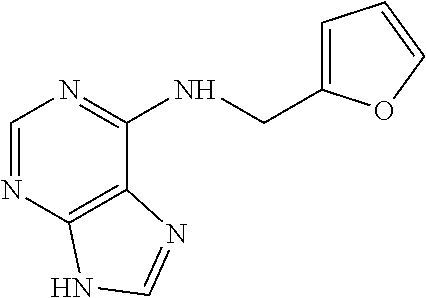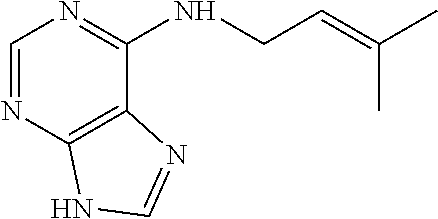Plant Growth Regulating Composition and Methods for Making and Using Same
- Summary
- Abstract
- Description
- Claims
- Application Information
AI Technical Summary
Benefits of technology
Problems solved by technology
Method used
Image
Examples
examples a-d
Preparation of Examples A-D
[0091]A water soluble plant growth regulating composition in granule form was produced in Examples A-D by a milling and extrusion process. The dry powder ingredients were bag mixed thoroughly. The resulting powder mixture was hammer milled through a 0.8 mm screen. Water was added gradually to the powder while mixing in a Kenwood food processor until a doughy material suitable for extrusion was formed. The doughy material was extruded through a 0.8 mm screen using a Kuji benchtop KAR75 extruder. The resulting granules were tray dried in an oven at 55° C. for approximately 4 hours. The dried granules were sieved through 2 mm & 0.25 mm screens to remove oversized particles and fines.
[0092]The gibberellin employed was GA4 (92% pure), the cytokinin employed was kinetin (98.5% pure), and the auxin employed was indole-3-butyric acid (98% pure). The surfactants employed in Examples A and D included a sodium salt of naphthalene sulfonate condensate (NSC) powder (MO...
examples e-p
Preparation of Examples E-P
[0105]To produce water soluble plant growth regulating compositions in granule form for Examples E-P, the following materials were pre-milled prior to blending with other ingredients: Indole-3-butyric acid, Kinetin tech, and Gibberellins GA4 / 7 (if required by the formulation) were all milled through a Retzsch Rotor Beater mill with 0.5 and 1.0 mm screens. For formulations containing magnesium sulfate, magnesium sulfate was milled through a Retzsch Rotor Beater mill with a 1.0 mm screen. Additionally BAP, Gibberellin GA3, and sodium NAA, where applicable, were passed through a bench top hammer mill with no screen fitted. After the pre-milling, all the dry powder ingredients were mixed thoroughly. The resulting powder base was passed through a hammer mill. Water was added gradually to the powder base to make a wetted mass suitable for extrusion. The wetted mass was then extruded through a 0.8 mm screen. The resulting granules were tray dried in an oven at 50...
examples e-l
Evaluation of Examples E-L
[0106]For Examples E-L, granules were prepared having the following compositions.
TABLE 5Example Granule Composition (% w / w)ExampleEFGHIJKLGibberellin GA4 / 70.250.252.512.5 0.250.032 0.25Gibberellin GA30.25Indole-3-butyric acid0.370.373.718.50.370.0460.37Sodium NAA0.41Kinetin0.760.767.638.00.760.0920.76BAP0.76(NSC) powder3.753.753.753.753.753.753.75SINS Powder1.881.881.881.881.88 1.881.88Atplus UCL 100710.0Zinc EDTA (tetrahydrate)9.02Manganese EDTA (assumed6.44anhydrous)Copper EDTA (anhydrous)1.27Lactose monohydrate carrier92.992.9 92.980.623.177.588.6Magnesium sulfate92.9Water, as wt. % of dry powder7.87.27.98.19.24.38.27.2Batch Size, kg1.01.01.00.90.90.90.90.9
[0107]All batches processed satisfactorily except for those containing an alternative water soluble filler. Batches with magnesium sulfate as a water soluble filler could be extruded, but gave a low yield of dusty granules. Using ammonium sulfate or sodium sulfate as a water soluble filler gave materia...
PUM
 Login to View More
Login to View More Abstract
Description
Claims
Application Information
 Login to View More
Login to View More - R&D
- Intellectual Property
- Life Sciences
- Materials
- Tech Scout
- Unparalleled Data Quality
- Higher Quality Content
- 60% Fewer Hallucinations
Browse by: Latest US Patents, China's latest patents, Technical Efficacy Thesaurus, Application Domain, Technology Topic, Popular Technical Reports.
© 2025 PatSnap. All rights reserved.Legal|Privacy policy|Modern Slavery Act Transparency Statement|Sitemap|About US| Contact US: help@patsnap.com



